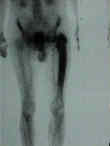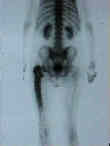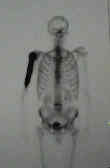- Discussion: 
- a chronic progressive disease osteoblasts and osteoclasts which results in abnormal bone remodeling;
- etiology, staging, and pathogenesis
- prevalence:
- uncommon in pts under age of 55 yrs but relatively common in later life, occurring in 3-4% of persons over 55 yrs &
occurs in 10% in pts over age 80;
- reference:
- A comparison of the amount of vascularity in pagetic and normal human bone.
- Clinical Presentation:
- frequently is asymptomatic and diagnosed incidentally on x-rays obtained for other purposes;
- may be localized to only one or several bones;
- relative frequency of involvement: pelvis, femur, skull, tibia, and least often involved is the vertebrae;
- wt bearing bones:
- may present w/ pain, increasing deformity, Pathologic Frx,
- local pain & tenderness over the affected bone are frequent.
- one or many bones may be involved.
- there may be night pain unrelated to change of position
- ref: Images in Clinical Medicine. Saber Tibia in Paget's Disease of Bone
- spine:
- neural compression may be the presenting problems;
- skull:
- headache and deafness due to skull involvement;
- hat size may increase;
- skull radiographs may reveal osteoporosis circumscripta which is a lytic lesion seen in the early stages of Paget's disease;
- ref: Images in Clinical Medicine. “Cotton Wool” Appearance of Paget's Disease
- cardiovascular:
- may have high output failure and high pulse due to increase blood flow thru Pagetoid bone;
- Histology:
- demonstrates excess osteoclasts resorptive activity; (occurs predominantly in the early resorptive phase);
- bone marrow is replaced by fibrous tissue and disorganized trabeculae;
- paratrabecular fibrosis;
- irregular - highly celluar lamellar bone w/ irregular cement lines;
- woven bone with osteoblastic rimming;
- occasional prominent cement lines.
- Radiographs:
- aggressive bone resorption;
- lytic lesions w/ sharp borders that destroy the cortex;
- new bone formation and sclerosis which causes thickening of the cortex and course trabeculae;
- cortices will appear thickened and trabeculae will appear coarse;
- skull radiographs may reveal osteoporosis circumscripta which is a lytic lesion seen in the early stages of Paget's disease;
- ref: Images in clinical medicine. Saber tibia in Paget's disease of bone.
- Bone Scan: 



- Lab Dx:
- there is a marked increase in alk phos, which reflects increase in bone formation (w/ symptoms alk phos is 2x normal);
- serum Ca & Phos, & acid phosphatase are usually normal (unless patient has been immobilized in which case
hypercalemia may occur);
- uric acid level may be increased;
- urinary hydroxyproline:
- increased serum levels of hydroxyproline levels & increased urinary levels of hydroxyproline;
- elevated urinary hydroxyproline is a reflection of bone lysis and may also occur in RA, hyperparathyroidism, and OM;
- urinary pyridinium / pyridinoline peptides can also be used as markers of increased activity;
- Treatment:
- indications for treatment:
- use of antipagetic medications prior to elective surgery is recommended;
- goal is to reduce hypervascularity assoc w/ active disease (3x alk phos) which will reduce the amount of blood loss at operation;
- to reduce bone pain (probably the most common complaint), excessive warmth over bones, headache, low back pain, &
neural compression;
- pain due to secondary arthritis from pagetic bone may or may not respond to antipagetic treatment;
- presence of moderately active asymptomatic dz than normal at sites where potential problems or complications exists (wt
bearing joints, spine, etc.);
- presence of monstotic dz of a tibia or femur with minimal elevation of alk phos are also treatment candidates;
- medications:
- bisphosonates:
- first line agent (low doses interfere w/ bone resorption where as high doses impair bone mineralization);
- fosamax (alendronate): 40 mg/day (first line agent);
- pamidronate: second line agent given IV (if fosamax is not tolerated);
- etidronate
- it is an oral agent and is less expensive than either of the calcitonins;
- while side effects are < calcitonin, the efficacy is also less;
- plicamycin
- calcitonin
- w/ extensive lytic disease in a wt bearing bone, calcitonin is the drug of choice esp with prior to elective surgery;
- indications: neurologic compression, given to patients prior to orthopaedic surgery or for pathologic frx, pain
or deformity;
- symptomatic benefit may be apparent in a few weeks;
- alkaline phosphatase will decrease after 3-6 months;
- major drawback is vomiting in 10-20% of patients;
- TKR in Paget's disease:
- see total knee replacement menu;
- tibial and femoral bowing associated with Paget disease often necessitates extramedullary cutting guides;
- arthritic knee pain must be differentiated from pain caused by Paget disease;
- arthritic knee is confirmed as source of pain if that pain is relieved after intra-articular local anesthetic injection or ineffectively
relieved following diphosphonate or calcitonin therapy;
- ref: Total knee arthroplasty for osteoarthrosis in patients who have Paget disease of bone at the knee.
- Paget's Osteosarcoma:
- references:
- Survival and management considerations in postirradiation osteosarcoma and Paget's osteosarcoma.
- Paget's Osteosarcoma - no Cure in Sight
- References:
On a form of chronic inflammation of bones. (Osteitis deformans).
Osteolytic Paget's disease. Recognition and risks of biopsy.
Long-term follow-up observations on treatment in Paget's disease of bone.
Efficacious management with aminobisphosphonate (APD) in Paget's disease of bone.
Experimental basis for the use of bisphosphonates in Paget's disease of bone.
New modes of administration of salmon calcitonin in Paget's disease. Nasal spray and suppository.
Combination drug therapy in treatment of Paget's disease of bone: clinical and metabolic response.
Vitamin D status in Paget's bone disease. Effects of calcitonin therapy.
Metabolic consequences of bone turnover in Paget's disease of bone.
Skeletal distribution and biochemical parameters of Paget's disease.
Dynamic radiologic patterns of Paget's disease of bone.
Total hip replacement for Paget's disease of the hip.
Osteotomy for tibia vara in Paget's disease under cover of calcitonin.
Osteolytic form of Paget's disease. Differential diagnosis and pathogenesis.
Paget disease of the calcaneus: findings on MR imaging..
Corrective Osteotomy for Deformity in Paget Disease.
Other links:
Paget's Disease of the Bone from the Orthopaedic Care Textbook
Paget's Sarcoma from the Orthopaedic Care Textbook
Paget's Disease of the Bone from the Orthopaedic Care Textbook

